Stalingrad, October, 1942. A bullet-dimpled Sd.Kfz. 250 halftrack grinds to a halt beside a vast Tractor Factory assembly hall. Its passengers – two flamethrower operators – hurriedly disembark. Within seconds the pair are directing a stream of blazing napalm through a window into a space where a Russian MMG team works frantically to unjam a misbehaving Maxim.
Restless, the camera tracks left along the ravaged facade of the building revealing as it does an immobilised Panzer IV Ausf. D and a lifeless Sd.Kfz. 222 armoured car surrounded by cowering German infantry. The support tank is busy hurling 75mm HE at the third-storey roost of the Soviet sniper who, last turn, slew Colonel Fischer, one of the 113th’s most capable and charismatic commanders.
After lingering on the stalled assault for a few seconds, the view shifts again. We strafe to the western end of the structure. Here things are going better for the invaders. Half-a-dozen squads have made it across a lead-lashed no mans land and driven the Ivans deep into the smoky, corpse-strewn interior of the plant. The progress allows a German gun crew in possession of an acquired 45mm ‘Sorokapyatka’, to emerge from cover and push their prize into a more promising position.
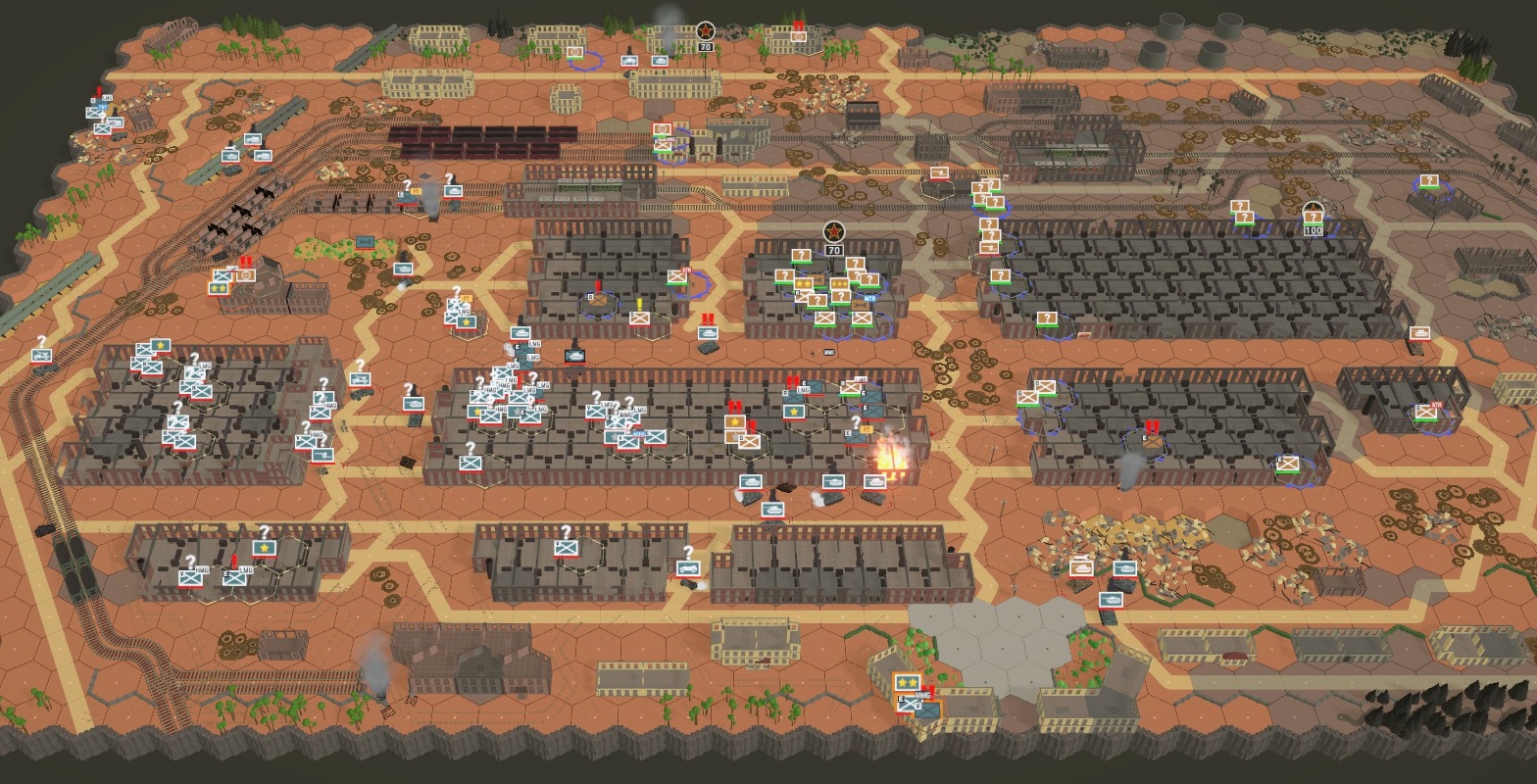
As if keen to find out what the little AT gun is hunting, the camera rises and retreats. Another giant battle-lapped factory building comes into view, then another, and another! Wherever you look there are knots of men advancing, falling back, and trading fire… AFVs moving, engaging, and expiring. Being an experienced wargamer, you’ve choreographed scraps in Stalingrad numerous times before. However, the scale and intricacy of the martial panorama now spread out before you, takes your breath away. At times like this Second Front’s manifold strengths seem far more important than its various shortcomings.
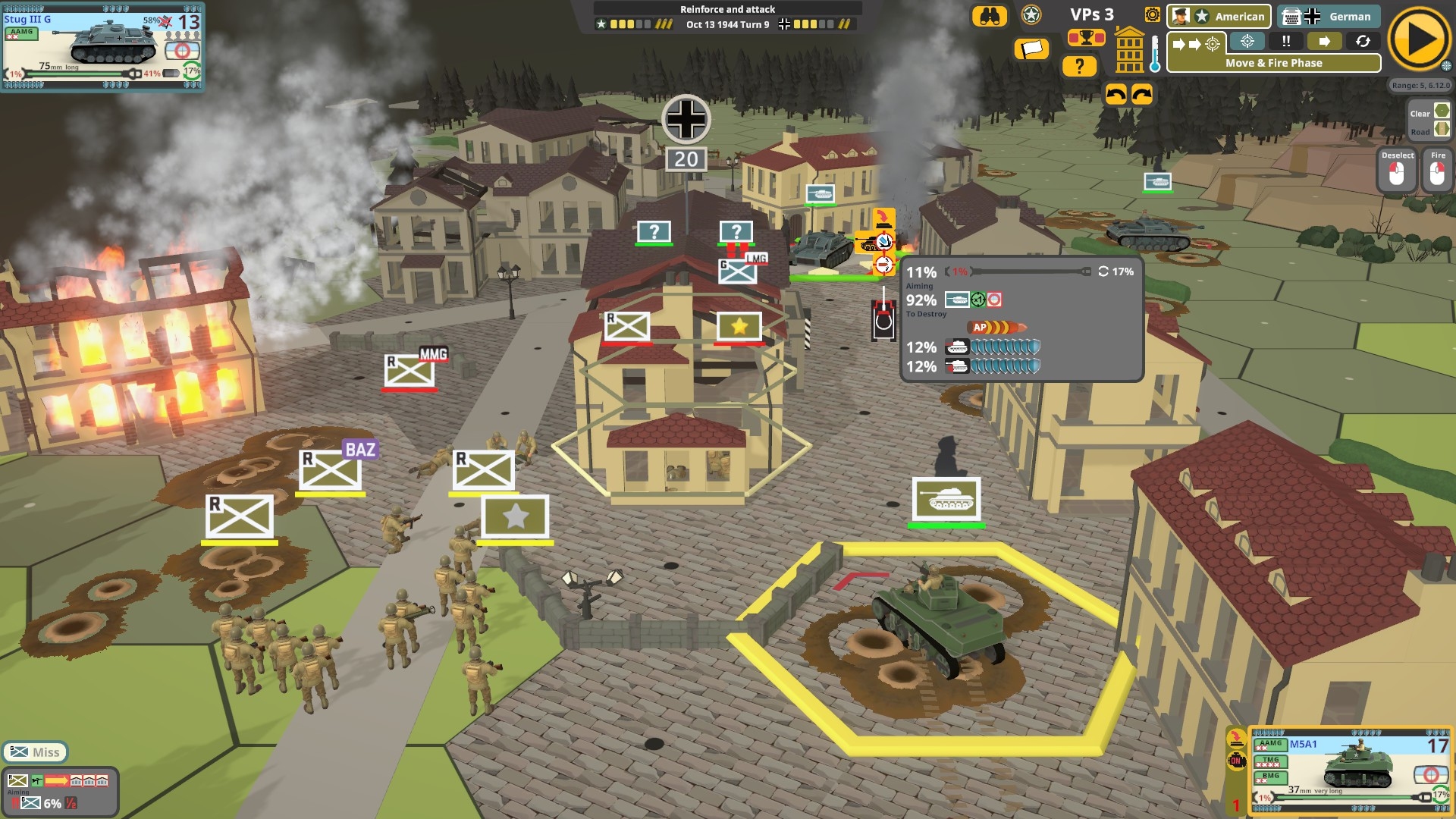
Released last Tuesday, Second Front is a sumptuous, lively, largely believable WW2 tactical wargame that manages to feel simultaneously modern and reactionary. Because the design borrows heavily from classic board wargame Advanced Squad Leader, we get somewhat fussy IGOUGO turn structuring (there are twelve phases in a turn) and a clutch of unnecessary realism compromises.
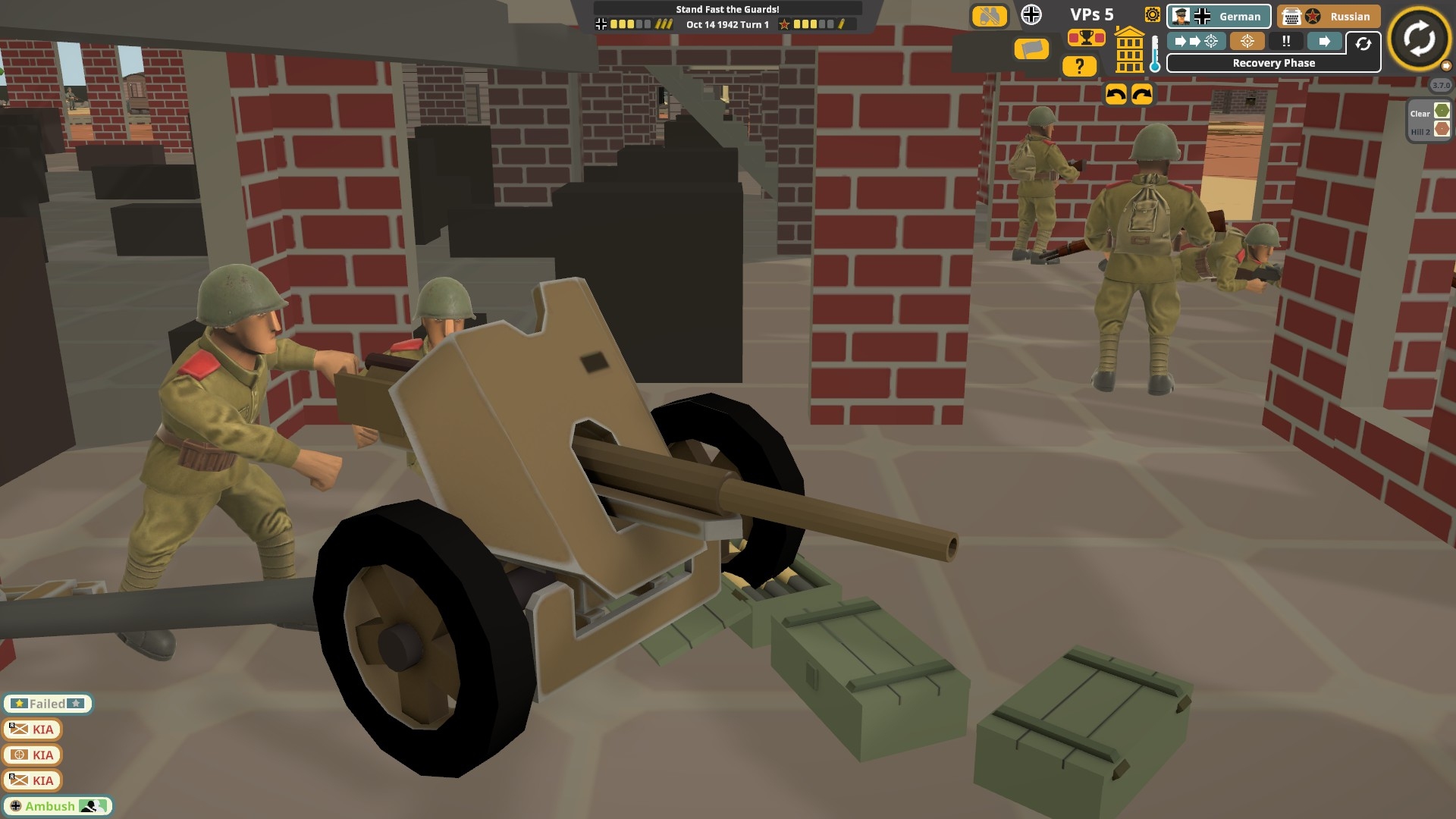
More positively, because Austrian dev, Jo Bader, likes his hexy battle sims rich, legible, ergonomic, and challenging, your £25 (until Feb 7) buys you an impressive roster of German, Soviet, and American units, pleasingly varied venues, unusually practical 3D visuals, an almost faultless UI, and an AI that copes admirably with most situations.
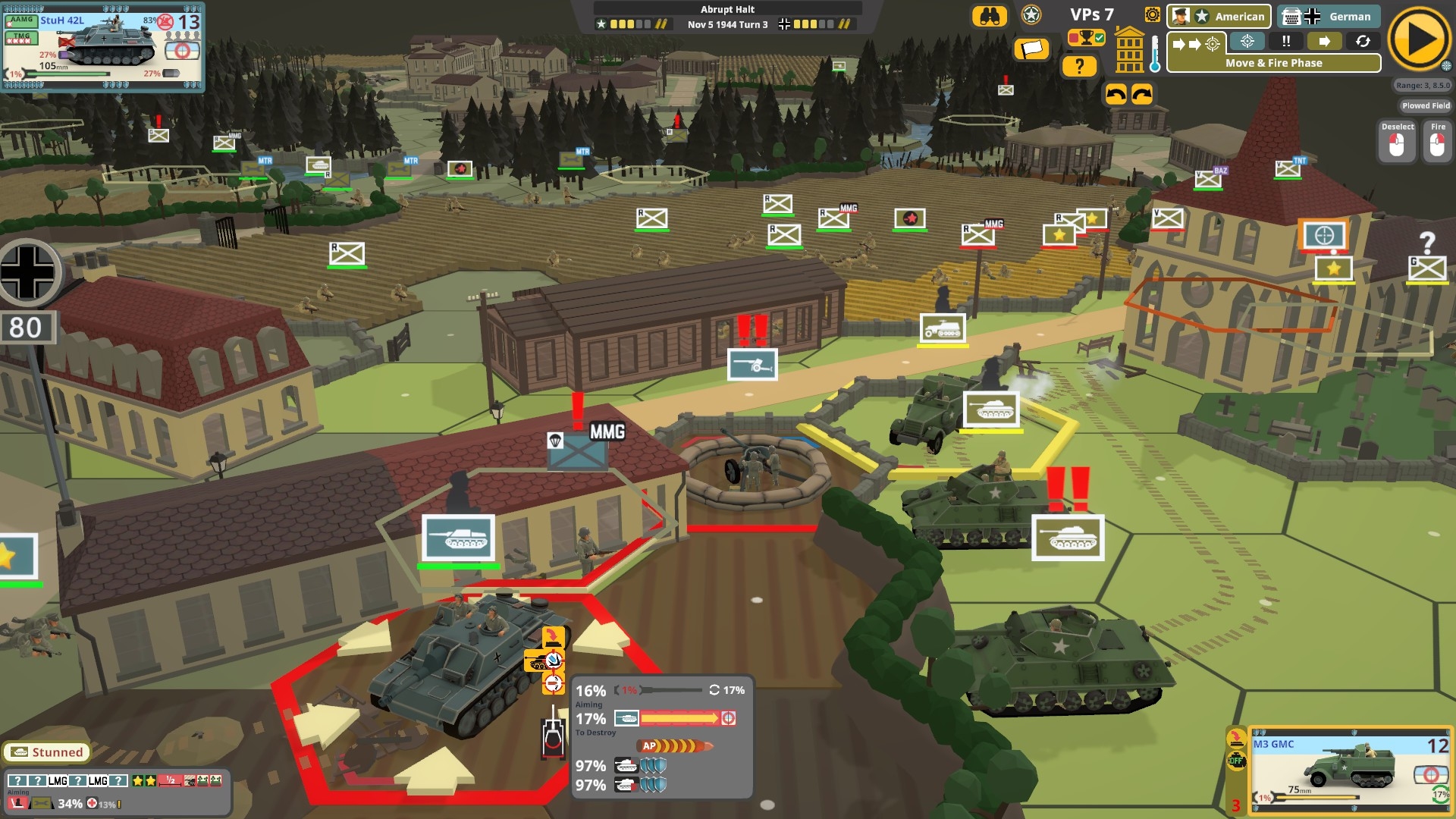
While ‘Gretchen’ needs maps liberally sprinkled with cover to do her thing (Present her with a challenge like ‘Conifer Corridor’ and she flounders) and has a few bad habits (These include failing to align AFVs sensibly on occasion, sometimes choosing sub-optimal targets for her tanks, and forgetting that using Bazookas and Panzerschrecks indoors can be dangerous), she generally handles her units with aplomb.
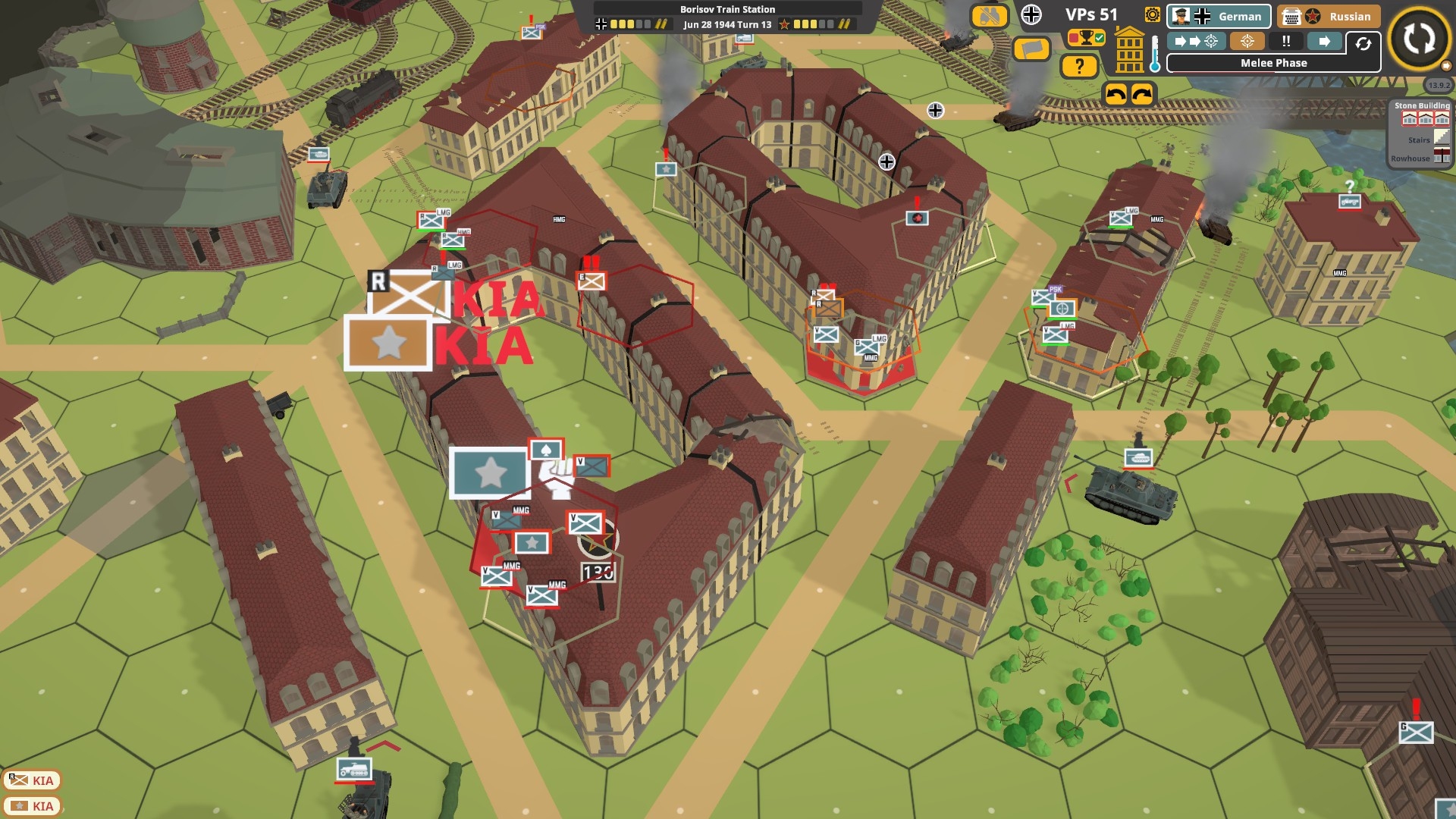
Fidgety by nature, her constant shuffling of infantry, even when defending, can seem aimless, even counter-productive, but seldom is. Unpredictable, confident on both the front and back foot, and good at exploiting cover, scavenging weapons, and rallying broken units, she ensures player victories never come easy.
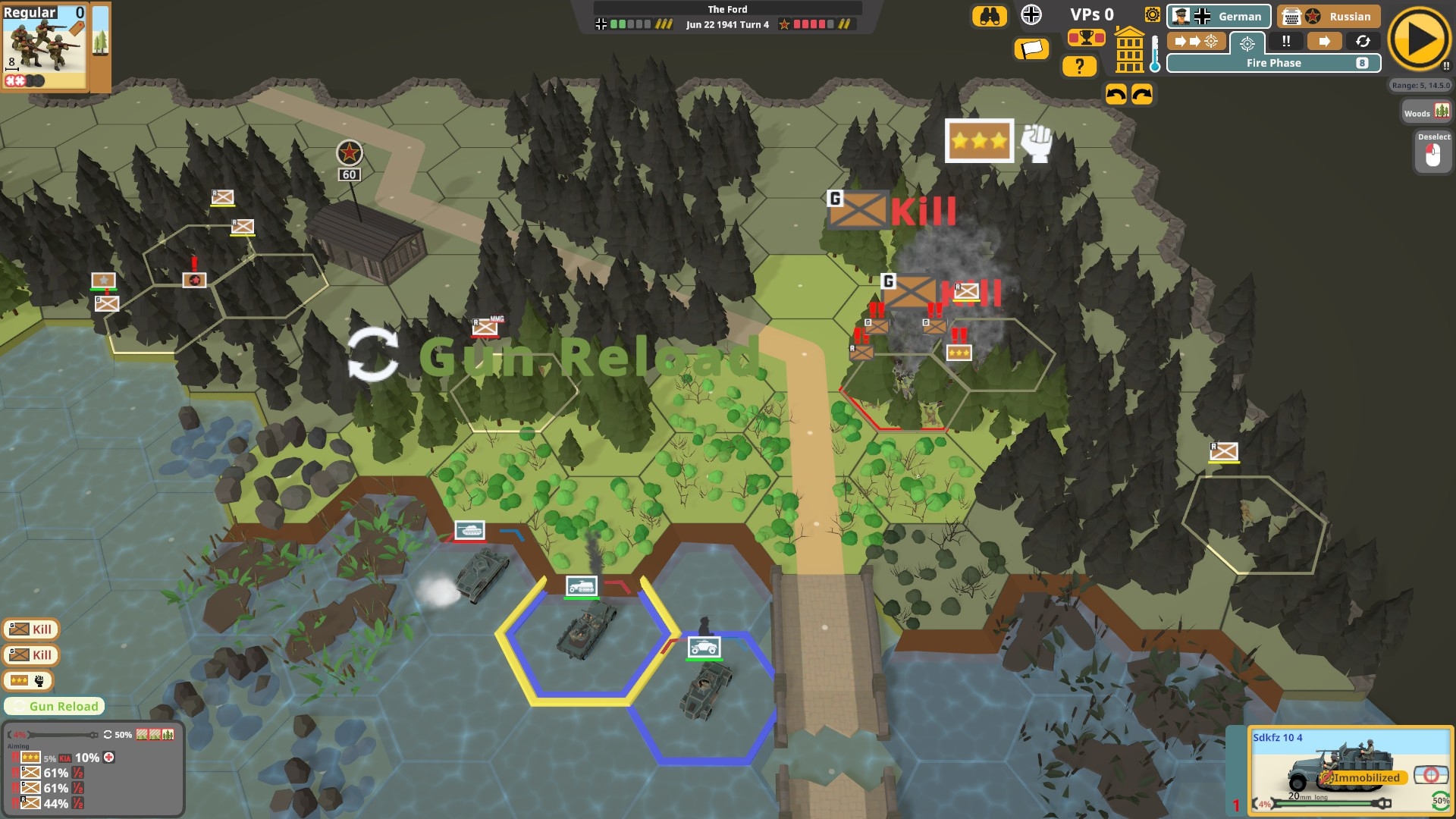
Her skill and restlessness combined with some questionable logic at the heart of the rules (Infantrymen under fire are more likely to break than become pinned or suffer casualties) gives SF’s engagements an effervescence that is hard to dislike. Once battle is joined, it’s rare for a turn to pass without a few red exclamation marks – indicators that a unit has ‘broken’ – germinating. Although broken grunts auto-rout, assuming you position leaders sensibly, retreaters usually aren’t unnerved/uncontrollable for long. In peer titles advances can sometimes feel grindy… mechanical… inevitable. The turbulent retreat-return cycles in Hexdraw’s debut ensures you’re constantly adjusting, rethinking, and improvising.
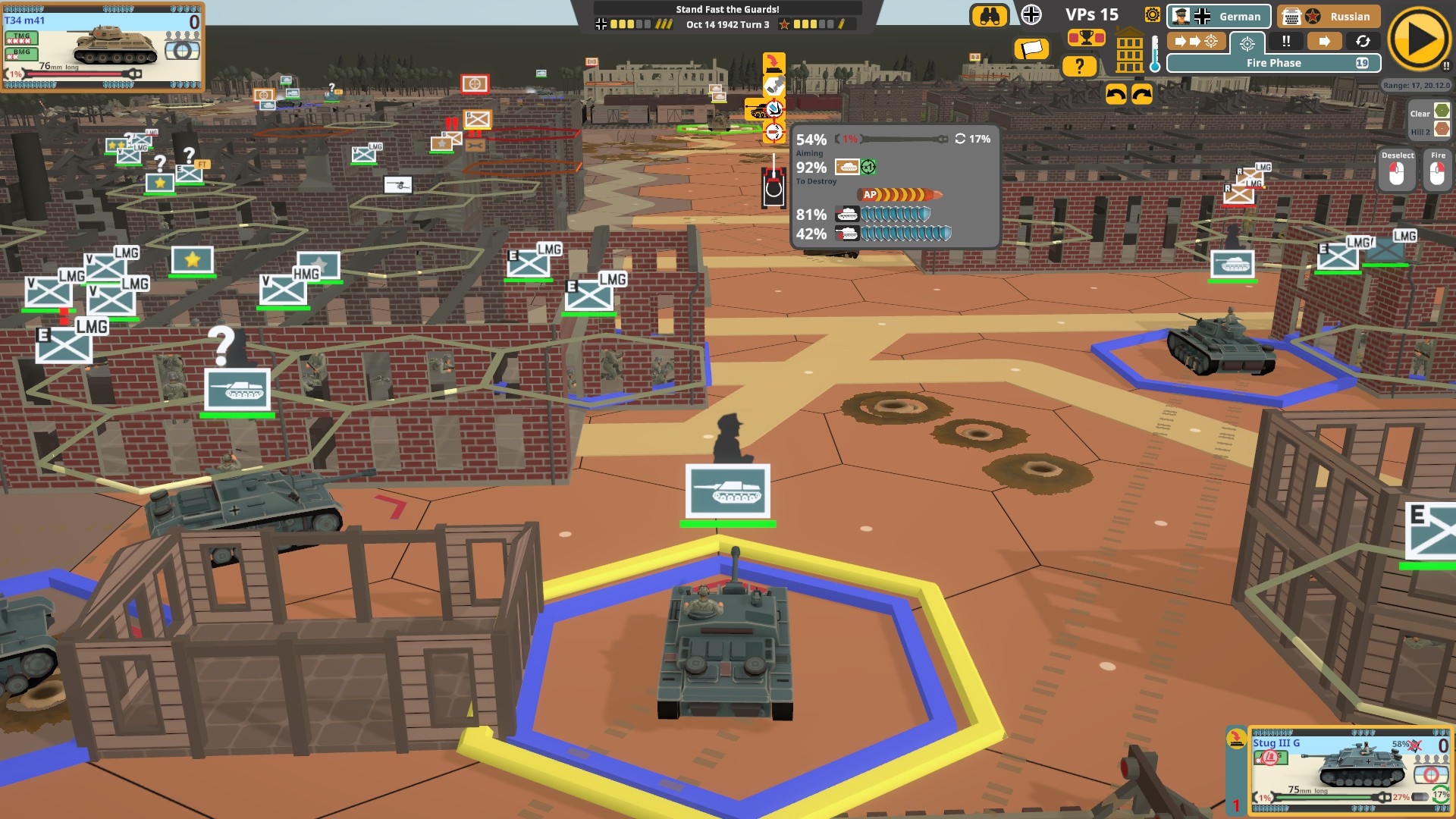
RNG-dependent plan-altering surprises such as weapon malfunctions, fires, ‘toughening’ and ‘weakening’*, and spontaneous hero generation, also enliven the aggro nicely. What a stroke of luck – that MG 42 in the church tower has just jammed! If Captain Kent’s band of brothers get their skates on they should be able to cross the field unscathed… Curses! The warehouse blaze started by that mortar bomb a few turns ago, is spreading fast. Looks like my snipers will need to find another vantage point soon… Gosh. I wasn’t expecting much from the two green squads I sent along the gully, but Lady Luck seems to adore them. One now has ‘veteran’ status, and the other has hatched a hero…
* Incoming fire can reduce or increase a unit’s ‘quality’.
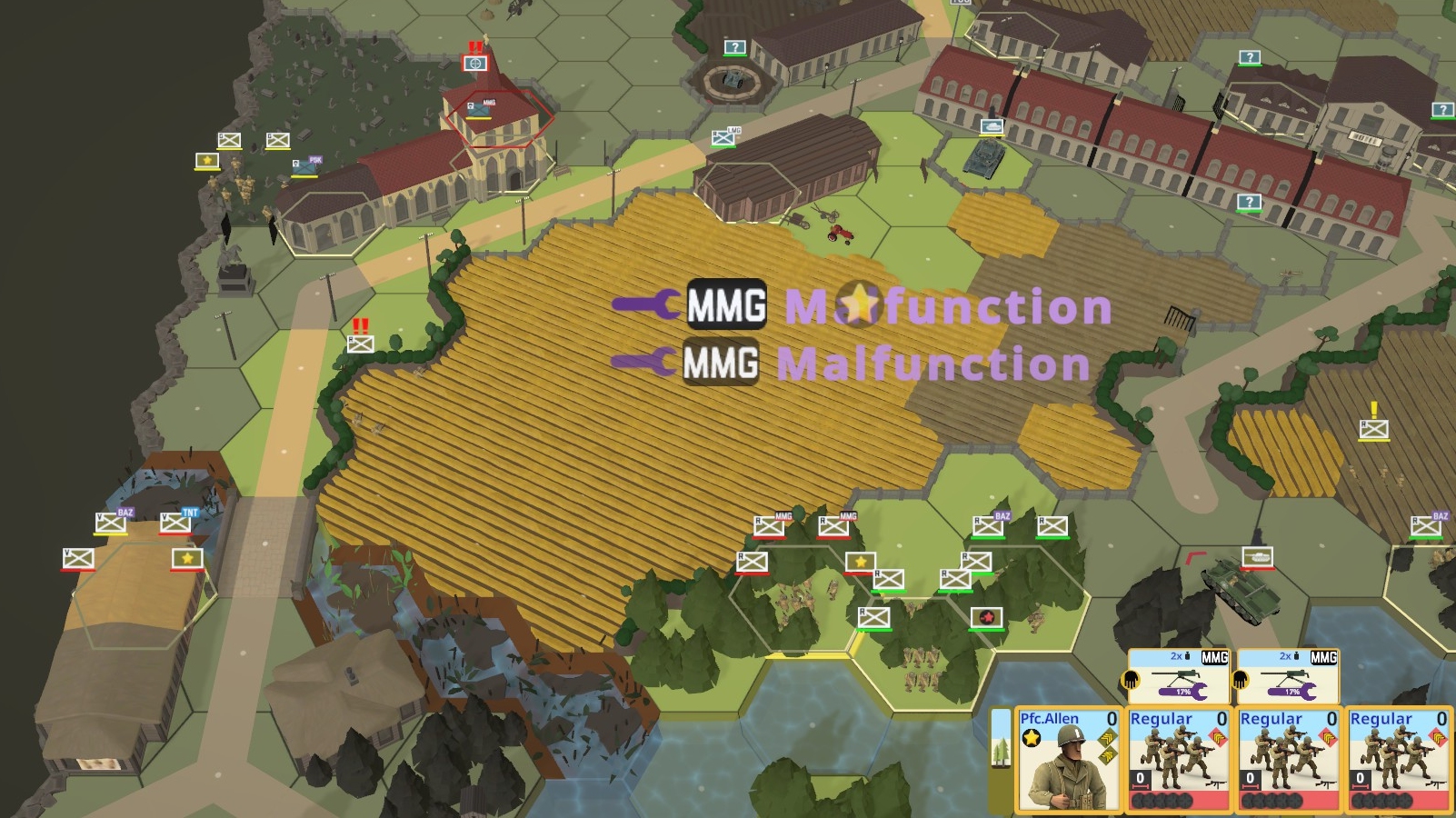
True, at times the enlivening goes too far. While fans of Combat Mission and Graviteam Tactics will be pleased to find SF’s tanky side enriched by things like one-shot armour kills, unbuttoning, close assaults, and smoke dischargers, they are likely to be appalled by the fragility of the game’s heavy weaponry and dismayed by what my colleague calls “the reload lottery” (see last week’s piece). In smaller scenarios, when the main gun of a key AFV packs up irrevocably early in a clash, you’ll need to be a stoical soul not to reach for the ‘quit’ button.
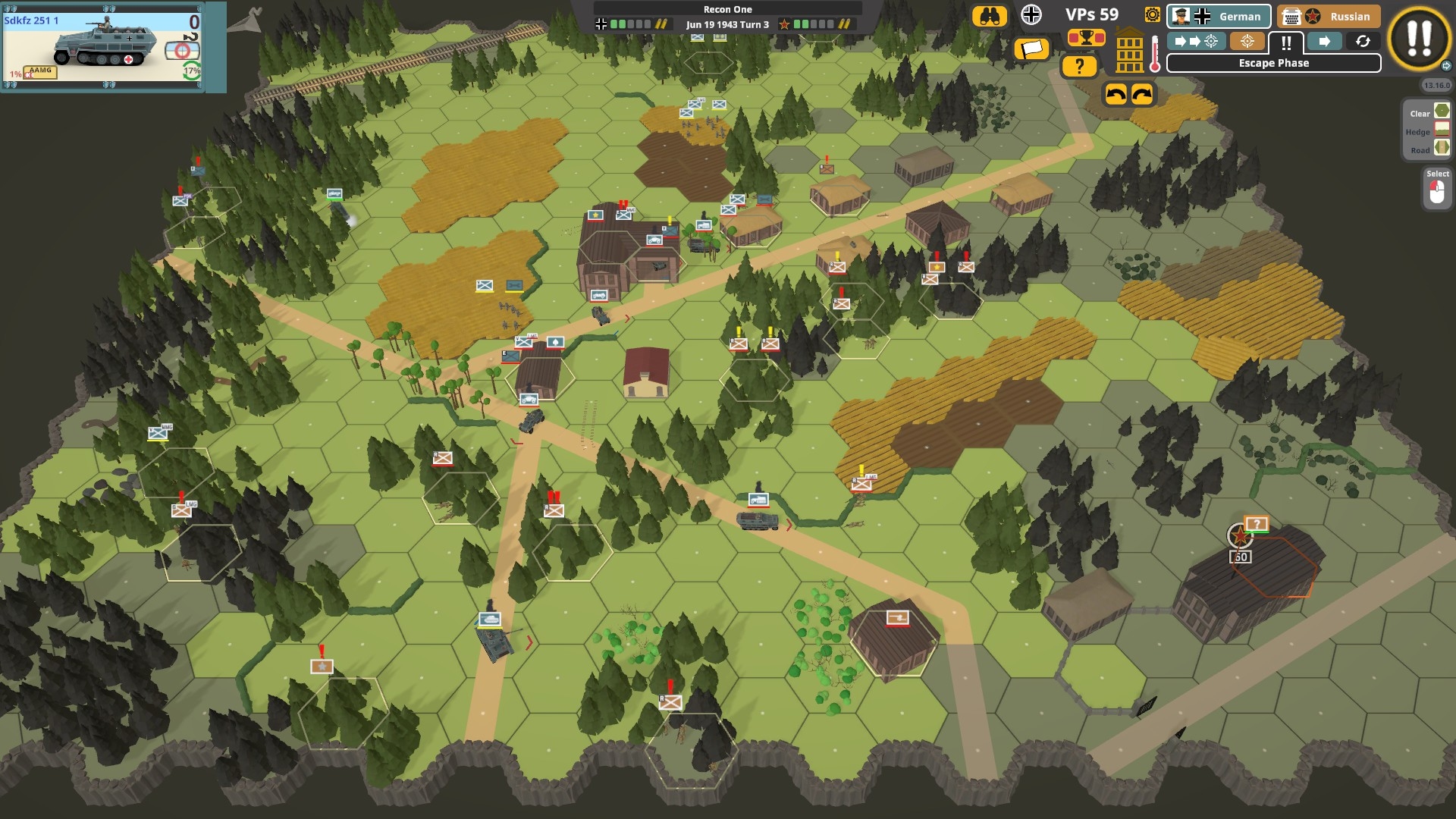
Grognards may also wrinkle their conks at SF’s halfhearted approach to Fog of War. Enemies are never mis-identified and, even when technically out-of-LoS, are rarely hidden from view. The LoS-dependent mortar mechanics (there are no spotters, off-map arty, or aircraft in the game) and the lack of friendly and speculative fire aren’t likely to impress realism jaegers either.
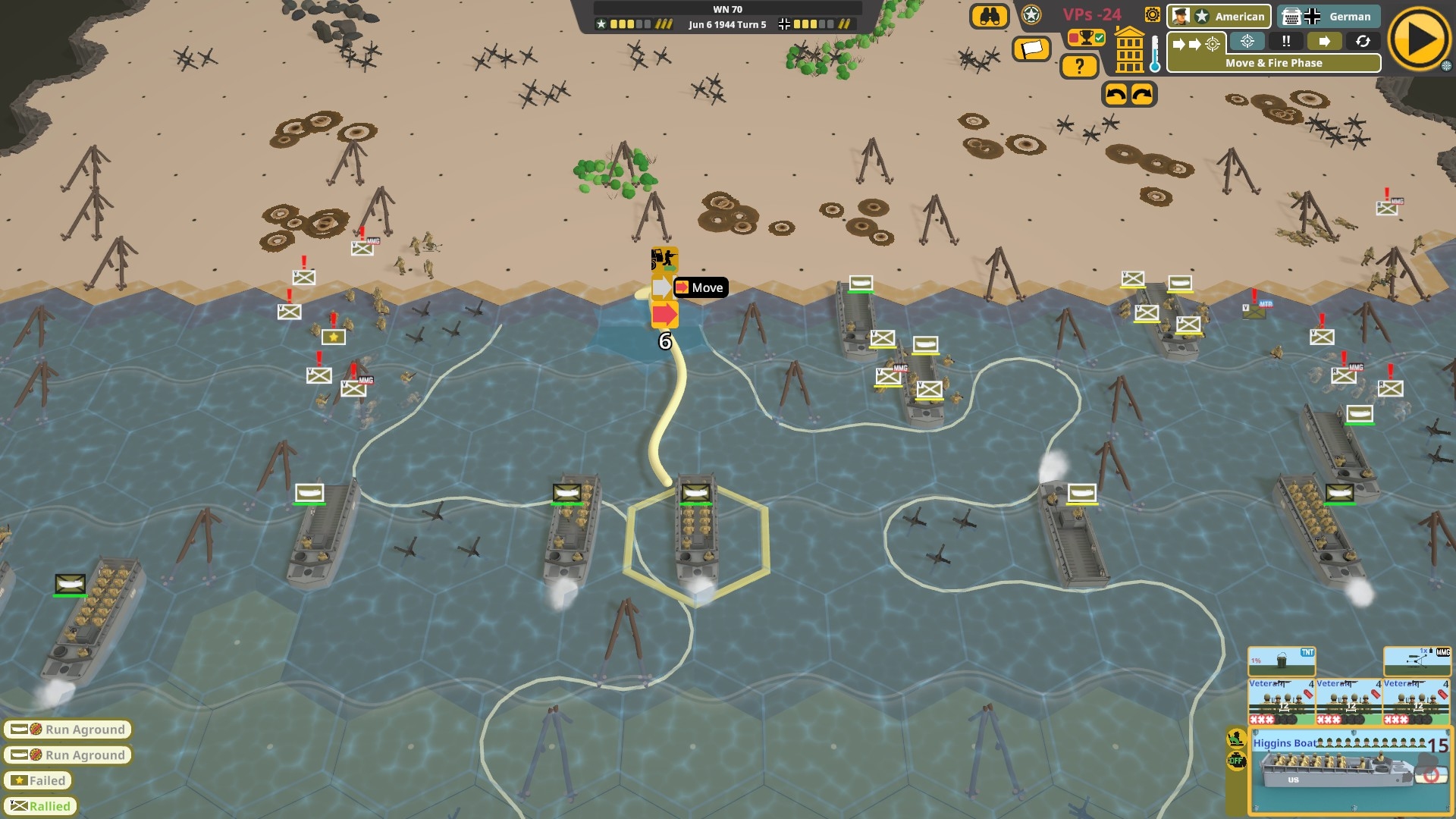
Forty-eight single scenarios, five multi-stage scenarios misleadingly labelled ‘campaigns’, and very friendly map and scenario editors, have, thus far, done a pretty good job of distracting me from omissions such as multiplayer and a skirmish generator. In short, boredom has been a stranger since the review code arrived. Over the last fortnight I’ve tussled for villages and valleys, towns and cities, rail yards and airfields. Men doing my bidding have crossed rivers under fire, cleared buildings floor by floor, and perished in droves on bullet-swept beaches. I’ve attacked and defended, sometimes simultaneously. I’ve probed, bypassed, relieved, and retreated. Only now, two weeks in, am I finding myself thinking “Why on earth doesn’t SF let me fight on random maps with units I’ve chosen and deployed?”.
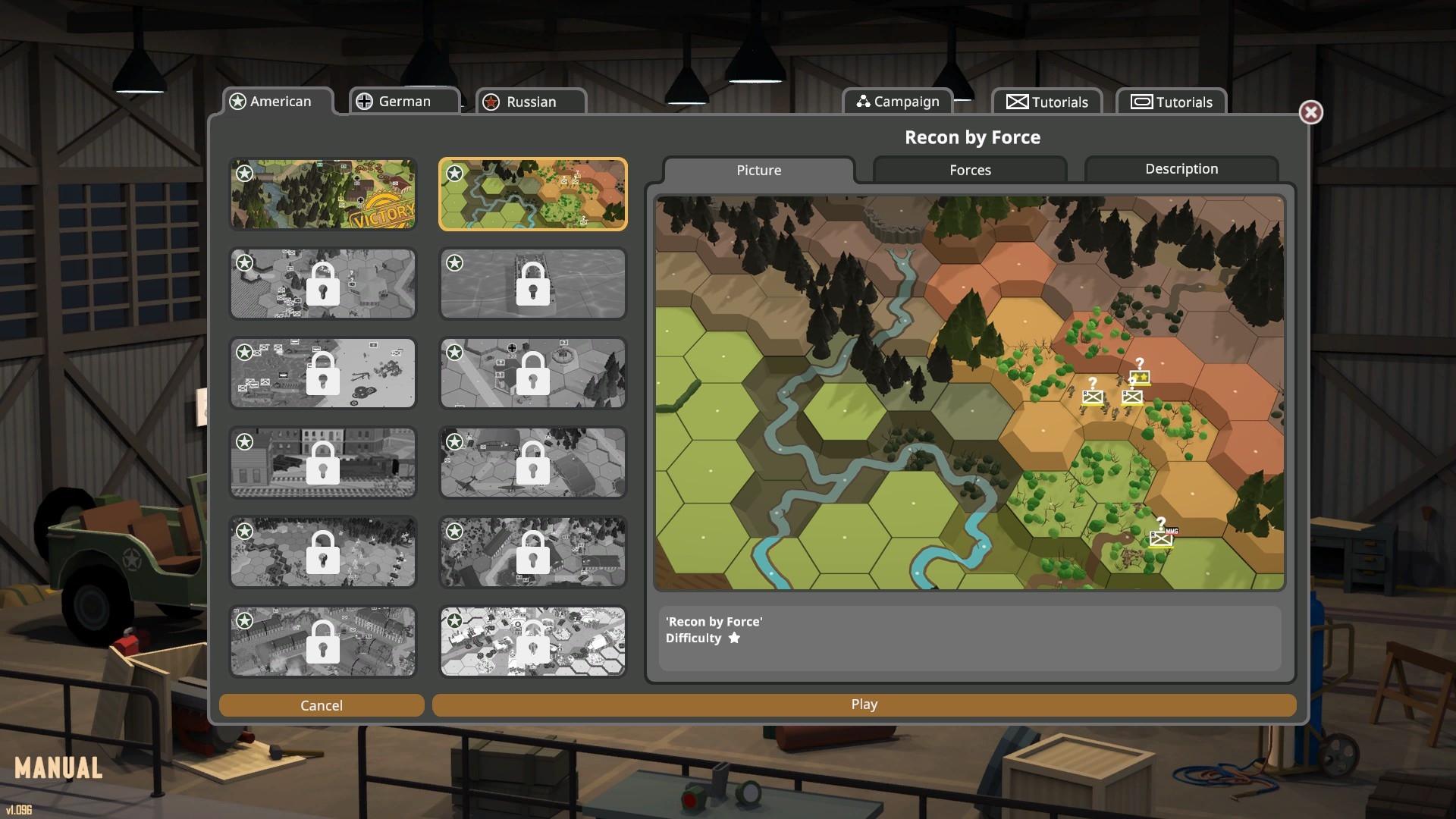
Finding the majority of the official* scenarios and campaigns locked at the start, was a mite irritating especially when I realised that in order to access the roped-off content I’d need to win unlocked battles without any help from the options menu. It’s hard to believe SF shipped without player-tweakable difficulty settings, yet player-tweakable difficulty settings there are none. Clearly, Jo hasn’t read ‘History or Victory?’!
* There are already plenty of unofficial creations in the Steam workshop.
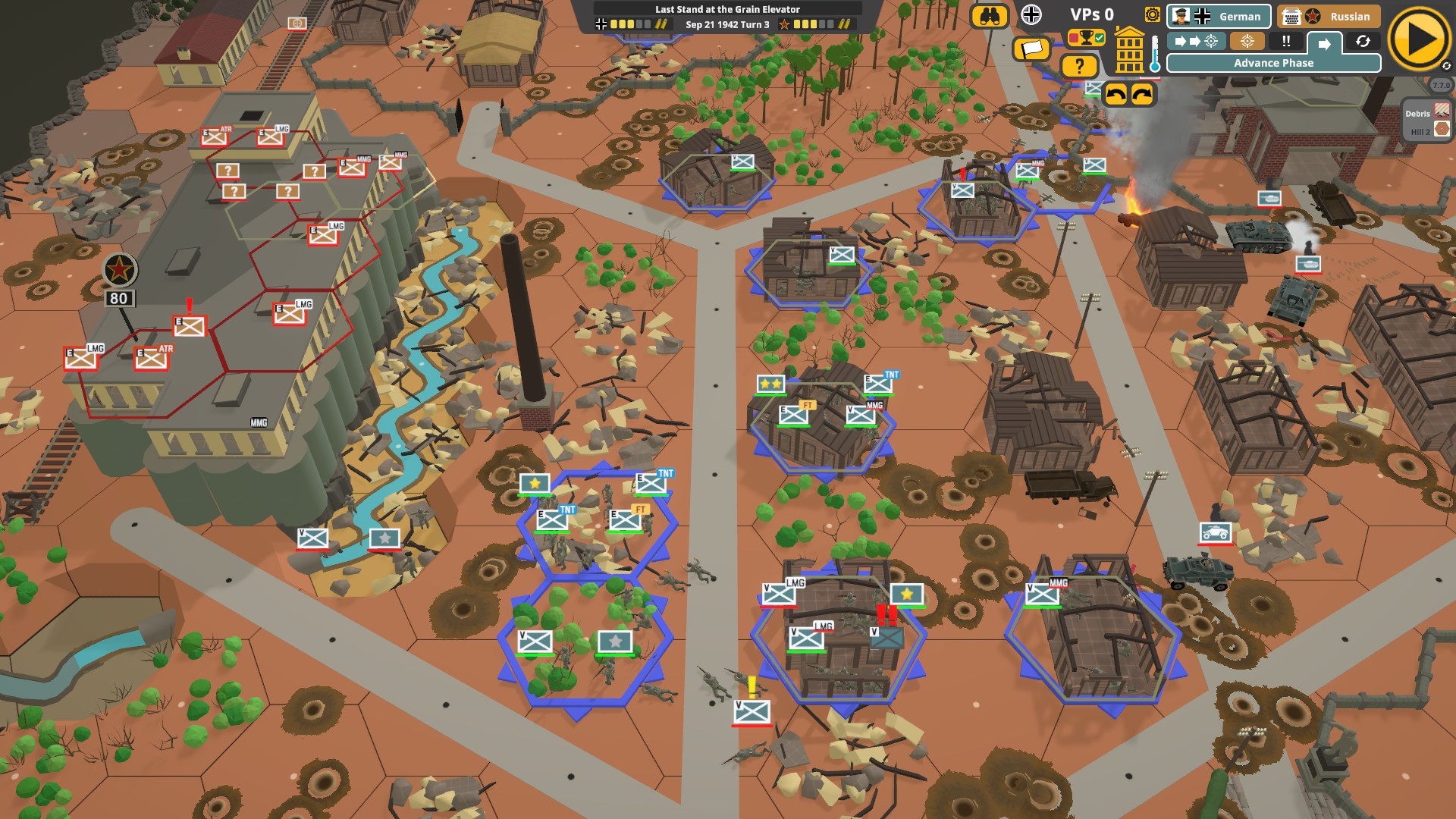
The clock is usually an important factor in single scraps. While, theoretically, you can triumph through unit destruction alone (the force ratio necessary for victory is decided by the scenario designer) more often than not* it’s your ability to occupy victory hexes before their value hits zero (VLs lose 10 victory points per turn) that determines the outcome of a battle. Holding the majority of VLs, or the same number as your foe, when the final whistle blows? Don’t expect a gentle ‘Tactical Victory’ or ‘Draw’ verdict. To SF’s uncompromising adjudicator, any player who doesn’t sweep the board is a loser.
* Scenarios in which exiting units is the name of the game are also possible.
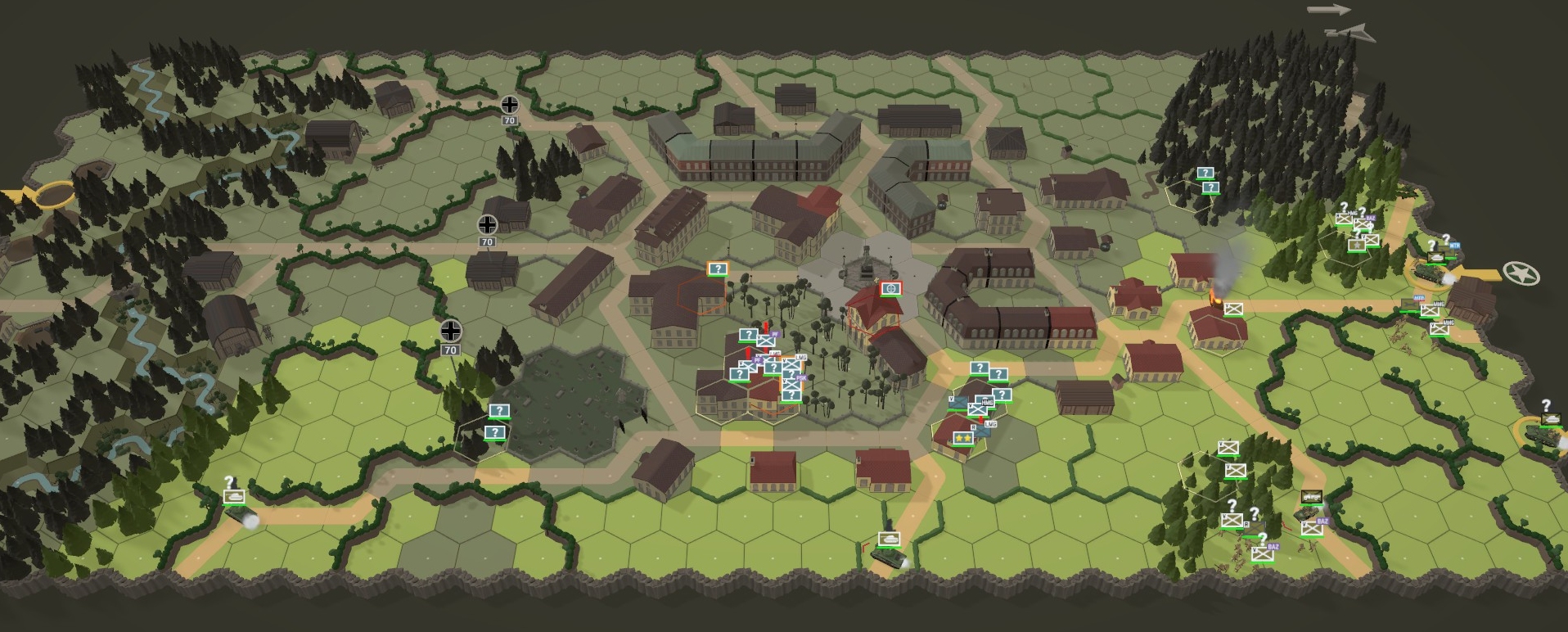
Success and failure in ‘campaign’ battles is determined in the same crude fashion, but happily has no impact on whether a campaign continues. Whether you took all the VLs in the previous engagement, or none, the next chunk of battlefield is guaranteed to appear (In campaigns you advance across a single persistent master map in stages) with what’s left of your assets, complete with any scavenged weapons, huddled on its friendly edge.
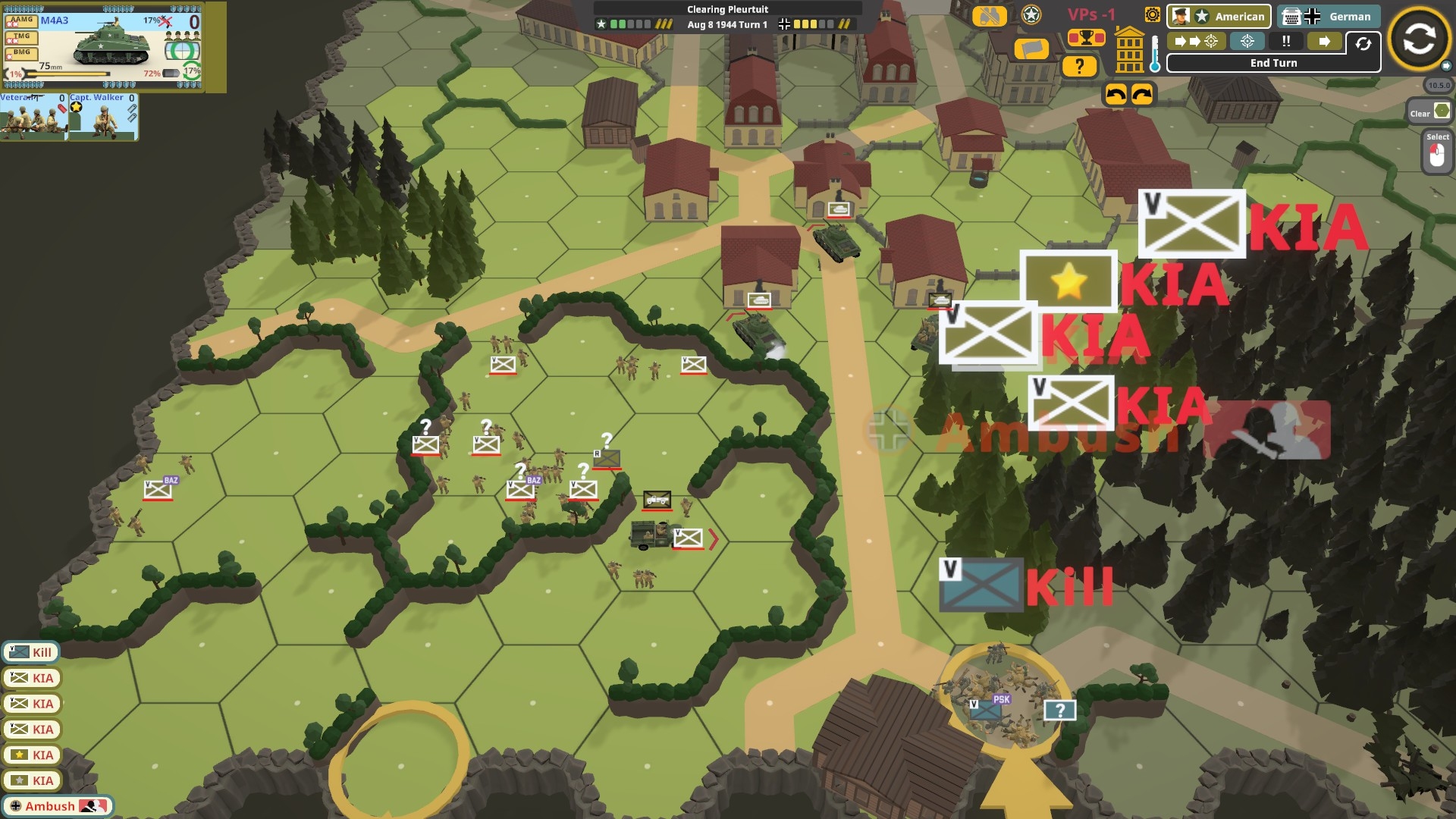
I’ve completed two of the five available campaigns during the past week. Both were surprisingly brief (3 to 4 battles) and, I regret to report, not entirely bug free (on one occasion, a clutch of my units started a battle in the same hex as enemies). Once the issues are fixed, and the amateur scenario smiths get to know the engine, the appeal of ‘campaigning’ will, I suspect, greatly increase.
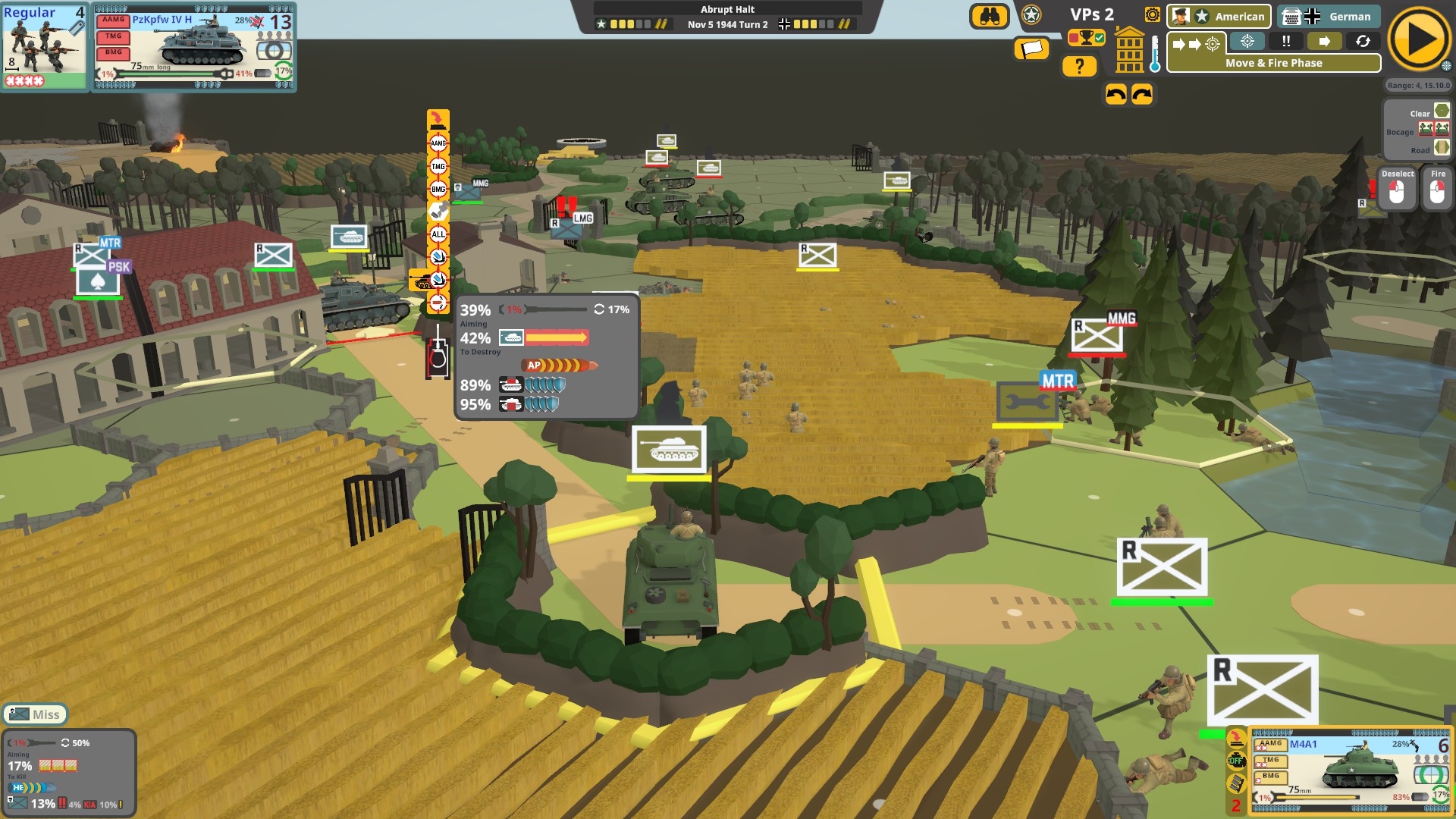
As there’s no way to customise challenge, and SF can punish rules ignorance and careless orders pretty harshly, there’s a fair chance your first few hours of post-tutorial play will be tinged with frustration*. My feelings towards the game warmed considerably once I’d grasped the finer points of the combat arithmetic. Ah, if I roll my Sherman into the next range band, then turn its engine off, it will get a substantial ‘to hit’ boost… Hmm, if I move the hopeless First Lieutenant Smith out of the MG team’s hex, and replace him with the able Sergeant Baker, the chance of breaking those Schützen with an M1919 burst doubles!
* Fortunately, tenderfeet don’t have to wrestle an abstruse interface while learning the ropes. Ignore shortcomings such as slow map rotation, unacceleratable unit animations, no ‘next unit’ or ‘undo’ button/hotkey, and a temporarily shackled camera (If the incredibly useful free cam from the preview build doesn’t return soon Hexdraw can expect grumbling in the next A2Z) and the command apparatus is excellent.
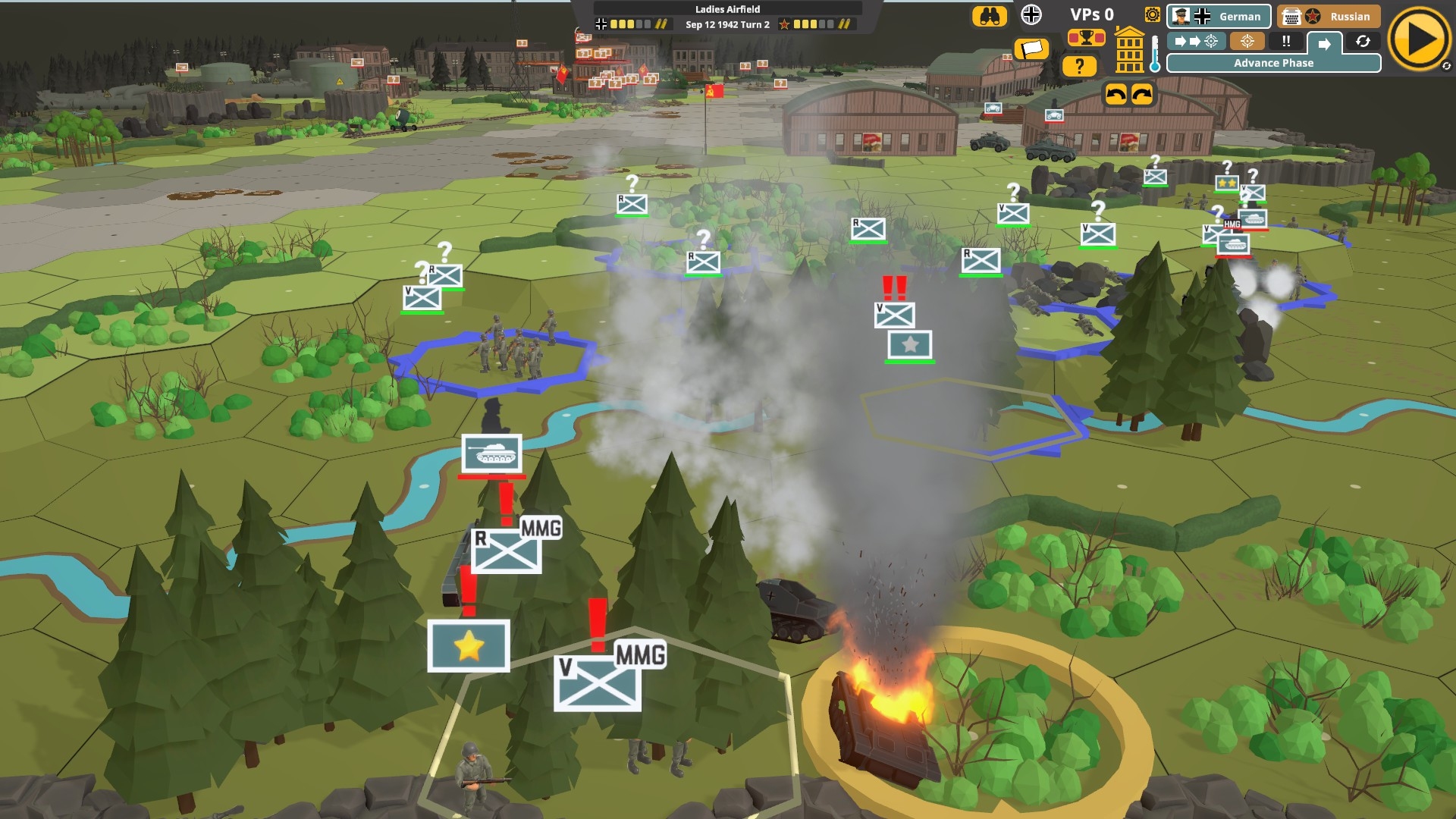
Vital too to frustration-free play is understanding how opportunity fire works. ‘Baiting’ enemies into squandering their reactive fusillades is one of the most important tricks in a player’s tactical toolbox. My verisimilitude-venerating colleague, Roman, insists this is proof SF “gets WW2 wrong”. I, on the other hand, prefer to think of my sly ‘Shoot me! Shoot me!’ manoeuvres as diversions and feints.
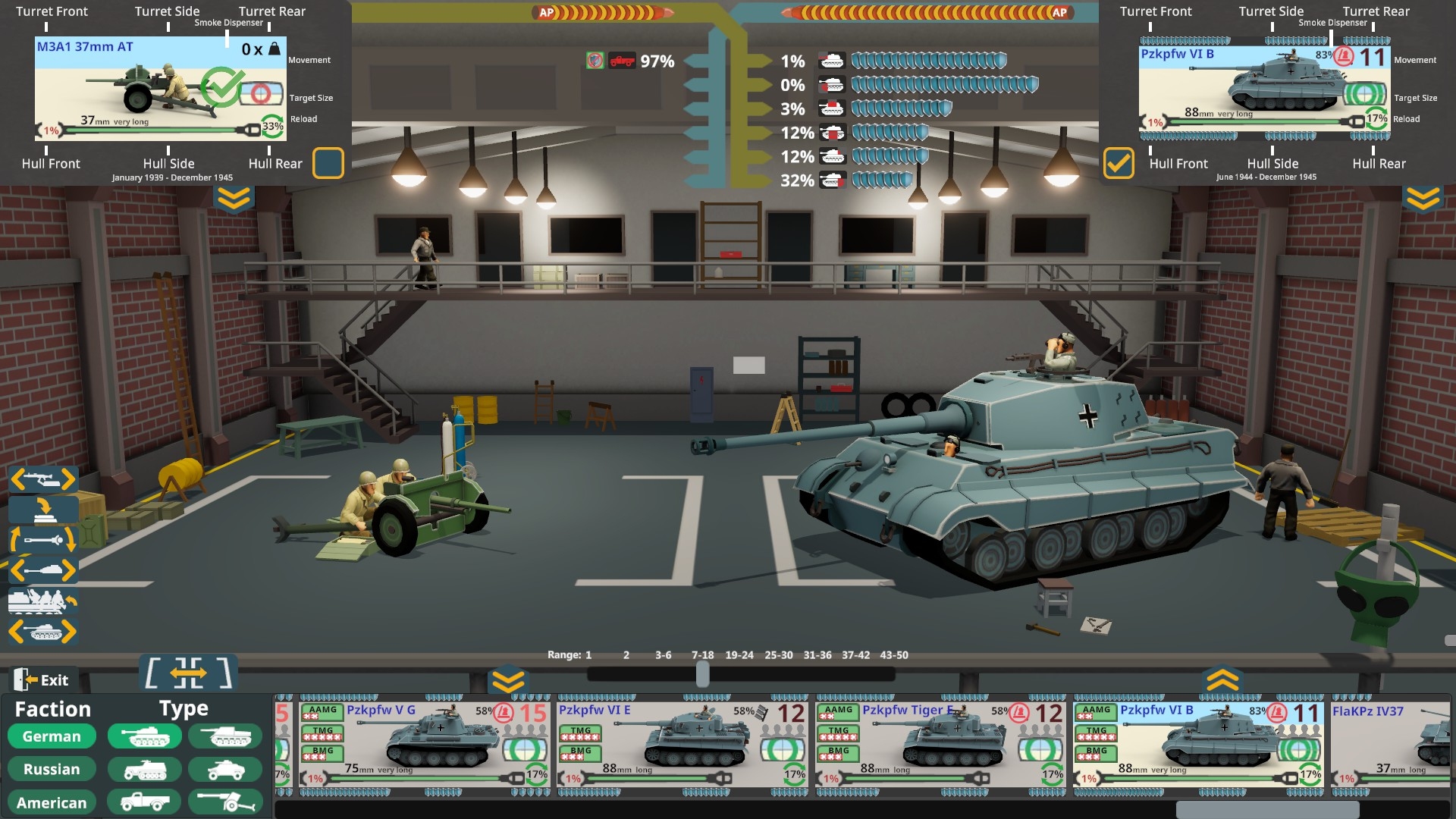
Talking of Roman, last week, I was pretty confident his concerns would melt away if he pressed on. Well, he has pressed on, and truth be told he remains sceptical. In fact, my chum’s unease with SF’s realism blindspots seems to have increased rather than lessened during the past seven days. Yesterday’s bonnet bee was overpowered 37mm AT guns. Today’s is suppression. He feels Hexdraw’s failure to put suppression at the heart of their infantry combat model is a huge gaffe.
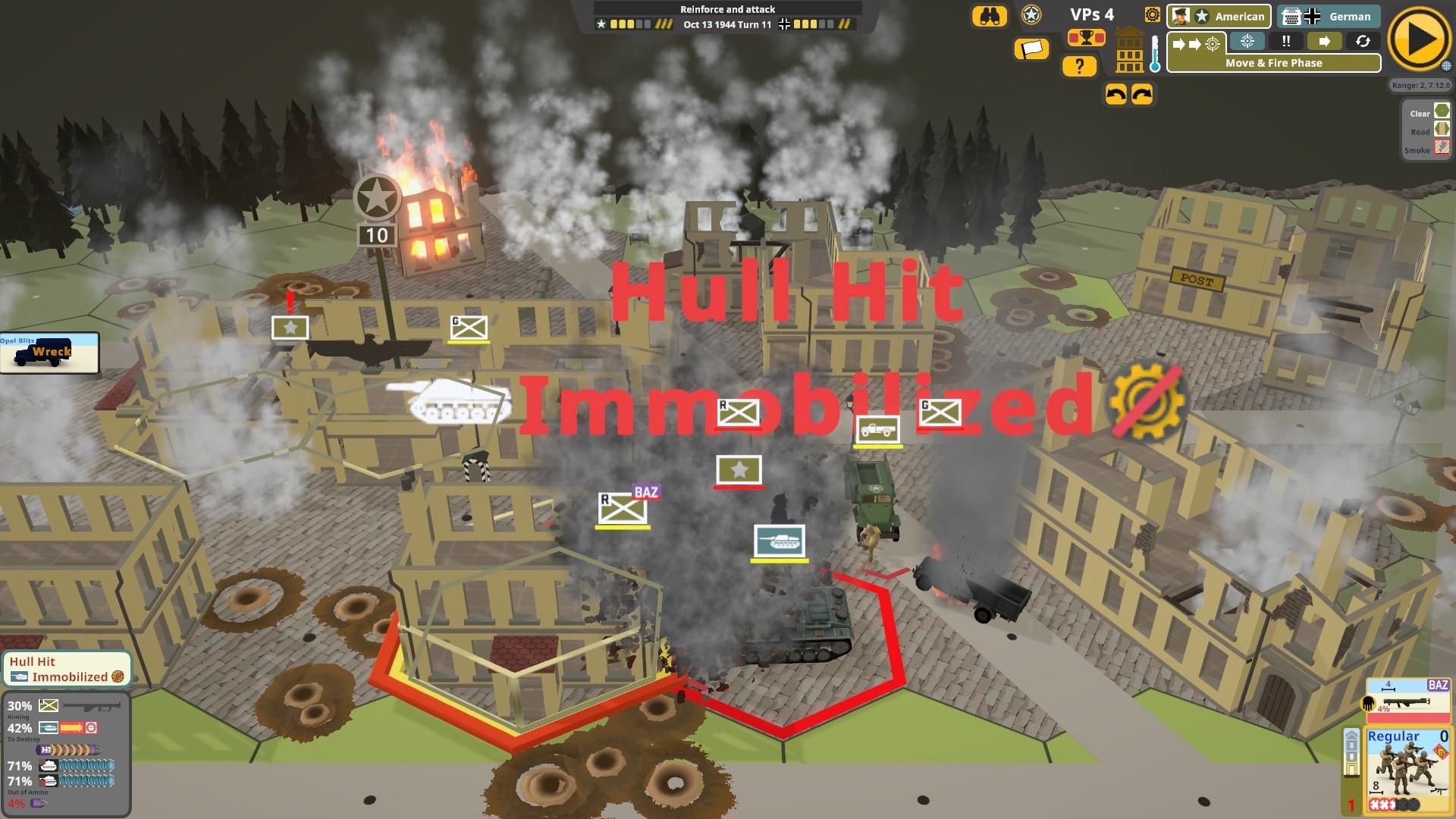
I can see where he’s coming from, but I suspect the changes Roman would make to SF if he had the power, would sap colour and excitement from one of the most colourful and exciting WW2 wargames I have played in years. At present, does Second Front deserve to be spoken of in the same reverential tones as Combat Mission, Close Combat, and Graviteam Tactics? Probably not. Is it as perfect a pop wargame as Battle Academy 2? No. Will 2023 furnish us with a smarter, fresher, more thrilling tactical wargame? I doubt it.

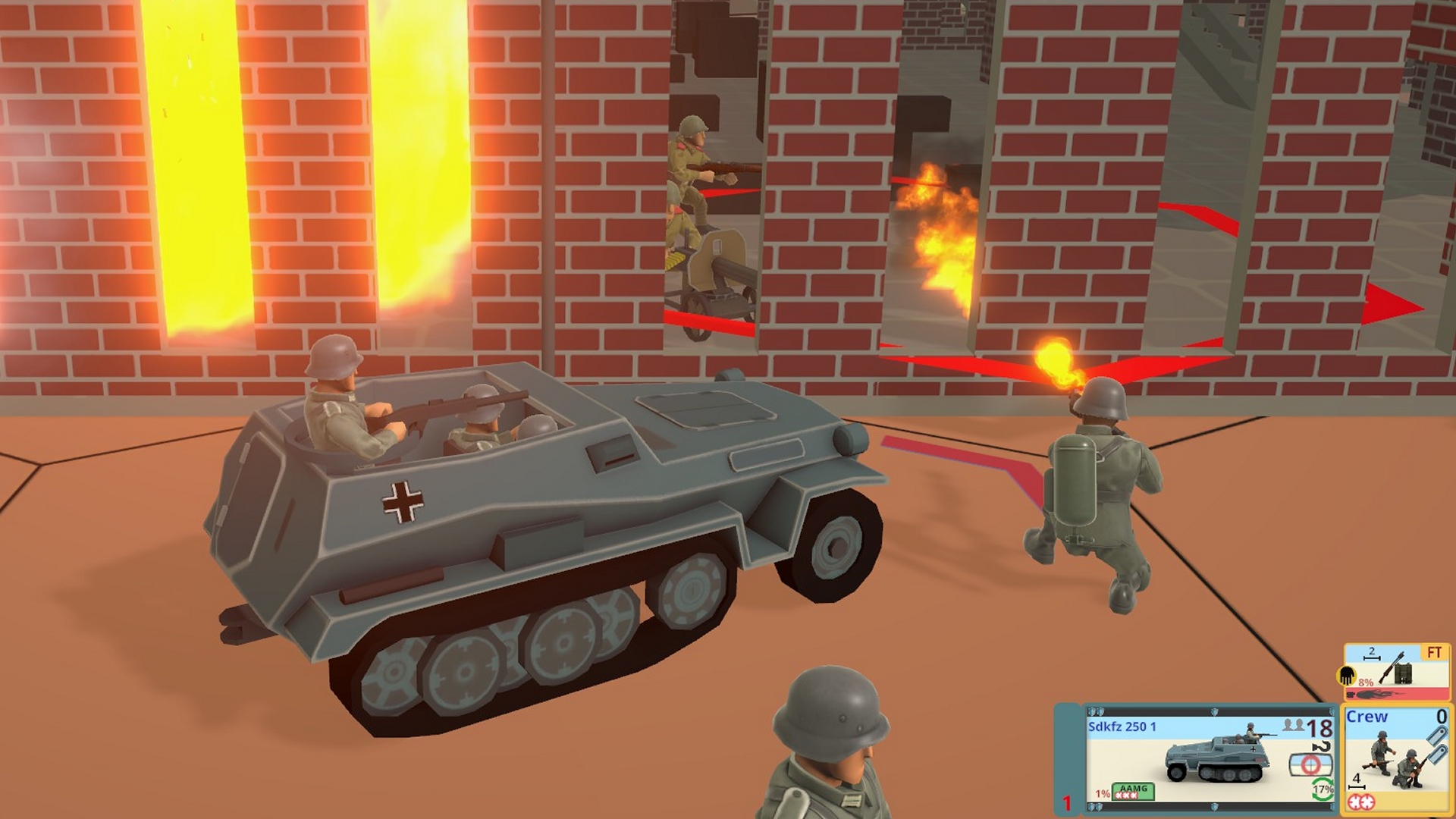
8 hours of gameplay invested..
I was looking forward to it and I tried to enjoy it. But I can’t
The RNG-based combat rules aren’t realistic or enjoyable. It makes sense for a table top game where rolling dice is the ONLY way to determine results, but the lack of cumulative or compound effects in engagements are completely bonkers.
How is it that 3 friendly rifle squads can fire on a single enemy squad but the cumulative effects of being under fire from three squads make no difference? Each engagement in Second Front is treated like an isolated and separate event from one another. Second Front makes it impossible to truly apply MASS against an enemy force.
Battle Academy 1/2 are still superior titles that model combat and the effects of combat much more realistically and accurately.
Not to mention – no indirect fire in Second Front. Mortars are direct-fire only.
And then there’s other things – the game definitely feels like an under-baked indie Unity project – the long processing times between turns and phases, and the sound effects are really poorly done. It breaks immersion seeing weapons without any sound effects, or hearing the weak pitter-patter of troop movement and the tinny metallic sounds of unrealistic gunfire.
I’m sorely disappointed with SF – I love Battle Academy and was looking forward to something a bit more modern.
“Potentially my Game of the Year” -Tim Stone
This aged like a fine milk.
Not even close.
I think it’s possible to acknowledge Second Front has serious realism flaws while simultaneously admitting it can be highly entertaining.
Your point about SF treating every fusillade as an isolated event is very true. Logically, attacks should have some cumulative ‘suppression’ effect. I’m rather hoping modders figure out a way to up-realism the game’s infantry combat. Simply switching the break and pin chances would help.
Fwiw SF is ASL, with smoothed out turn structure to make it less back and forth. Suppression is modeled by broken units getting the desperation morale status, giving them negative modifiers up until the rally phase. More realistic models (Jim Krohn’s Band of Brothers for example) lead to more mechanistic approach: find, fix, flank, finish, repeat. Is it better? Yeah, probably. Does it put a smile on your face? This I’m not so sure. I like to think about ASL more as Kelly’s Heroes than FM 3-21.8, it’s a puzzle game, it’s a story generator.
The pins in ASL are relatively rare, you have to hit exactly the morale number to get one, while for breaking it’s everything below. Changing something like this risks messing up the balance of hundreds playtested Squad Leader scenarios, which, I have no doubt, are going get translated by the fans.
SF/ASL may have their issues, but what we’re seeing here is potentially unbottling of 40 years of creativity. This is huge.
If anyone is interested in the nuts and bolts of the system, the rulebook is freely available at: https://mmpgamers.com/support/aslsk/ASLSK4_Rules_September_2021.pdf
While I agree that a more realistic SF would probably be more mechanistic, I have sympathy with the ‘Romans’ – wargamers who’d like to see suppression, for instance, front and centre. If Jo could figure out a way to encourage people like Apocalypse to give the game a second chance, it would be splendid. If deep modability isn’t practical/likely, then perhaps some form of optional ‘suppression’ modelling could be offered. Each unit gets a suppression variable which increases when it’s fired upon (attacker’s ‘break’ odds +/- a dash of RNG?). The variable manifests as malus block(s) when a suppressed unit is firing, and dwindles at the end of turn. Obviously, it could play havoc with the balance of existing scenarios and confuse Gretchen, but if it helped broaden SF’s appeal and wouldn’t be a complete nightmare to code, I reckon it would be a worthwhile endeavour.
Replying to Tim here since I can’t reply to his comment below.
“If Jo could figure out a way to encourage people like Apocalypse to give the game a second chance, it would be splendid”
This game has been in development for a quite a while, and it appears that it was developed within a very small circle by a single developer with his own ideas in mind.
Unfortunately, it is very apparent that feedback is only taken from that same very small circle of people while others are often harassed or told that they’re “playing wrong” or “don’t understand the game” (often by beta testers and now moderators). I was harassed for leaving a negative review on Steam – told that my opinions were wrong, I was playing wrong, I didn’t understand the game, etc. It was really pathetic; Get over yourselves. This game has the depth of a mobile or children’s game, and the fact that anyone would mistake combat mechanics is nobody but the developers fault for not explaining it. The tutorials definitely don’t explain anything.
It also appears that the developer see’s nothing wrong with his game, nor does the small following of beta testers. The idea that the game is totally unrealistic isn’t even a thought that crosses their minds. I call this ‘being too close to the sun’. He’s been staring at this project for 3+ years, as has his beta crew. They see nothing wrong with it.
What’s even more hilarious – those same people just keep repeating the mantra ‘this is ASL’ while the hardcore ASL players continue to say ‘this is not ASL’.
Nice review Tim. I picked this up on Tuesday and haven’t had a huge amount of time to play yet. I like what I’ve seen so far but I’m still in those first few hours of post-tutorial play and some of the mechanics remain unclear.
e.g. I was interested to see your example of ‘if I roll my Sherman into the next range band’ – one of the things I’ve yet to grasp is how range affects the main weapon on a tank (as opposed to its machine guns, which seem to work like any infantry weapon). I did notice when playing around in the ‘Garage’ earlier that it displays a set of ranges (1, 2, 3-6 etc.) so maybe that’s it but couldn’t find any mention of this in the manual.
Hopefully some of the obvious initial annoyances will be addressed, the main ones for me are the slowness of the phases when the AI is thinking plus the lack of free camera control. I think some kind of range indicator when units are selected would be useful as well. There are some comments in the manual suggesting obvious missing features such as air support or off-map artillery might get added at some point too.
>> I did notice when playing around in the ‘Garage’ earlier that it displays a set of ranges (1, 2, 3-6 etc.) so maybe that’s it
Yes, those bands are pretty important to a tank’s ‘main gun’ to-hit chances. On reflection my example wasn’t great because the Sherman would have to wait until the ‘fire phase’ in the enemy half of the turn to exploit the shortened range (any benefits would be negated by its movement if it fired immediately after moving).
Unfortunately, until Hexdraw provide some sort of range overlay or indication in the tooltip, figuring out whether it’s worth advancing/withdrawing your AFV will require a manual hex count!
My hope was that Second Front would be similar to Steel Panthers, but that’s apparently not the case.
It’s a shame when one of the highly-anticipated most-accessible wargames comes out to such mixed reviews.
Too often the genre is plagued by either boring compromises to realism, or obtuse mechanics in order to punish new players who haven’t internalized the entire game manual.
However, some games prove to have remarkable long tails. I think of Fields of Glory 2, which released to modest reviews, but which has seen a half dozen DLCs since then, as well as a campaign-oriented sequel. Perhaps with a few months of love and polish some of the mechanics can be ironed out, the performance increased, and a steam sale could shoot this game to great future success.
Hopefully, the mixed reviews will encourage Jo to add difficulty and realism options. I think a fair bit of the negativity stems from the fact that currently beginners are forced to play a small selection of scenarios, and these scenarios are – when you’re still finding your feet – often pretty tough.
If I was him I’d unlock all the content, reintroduce the free cam (great for immersion and useful for analysing busy hexes), and give users a ‘longer scenario durations’ option, ASAP.
Must say I’ve found wonders with your choices but disagreed with opinions plenty over the years. But found out and kept up with many titles through your great writing. Oftentimes the writing was much better than the games. Second Front being no exception, at first glance seemed to promise the ease but also somewhat stale simplicity of Battle Academy. After all, how many tried and worn hex and counter advances through Normandys fields we’ve had already? It was a pleasant, pleasant surprise to encounter none of that mechanical inevitability of advance in Second Front. Seems you were right to have an eye on it all along. It’s held my attention incredibly well and generated dramas every turn, thrown a spanner into plans occasionally but all in good fun. Thanks for keeping at it and pointing at real gems! Here’s to a wave of scenarios, expansions and all that. And a thank you to the developer! Always a pleasure to witness a new mainstay appear and hit it off early on.
Glad to hear you’re enjoying SF, GC. I think once you accept that it’s more mercurial than most wargames, and start figuring out how to increase the likelihood of the mercury doing what *you* want, it’s great fun.
I hope the developer can minimize the amount of time spent waiting between phases or waiting for animations to play out. Locking non-campaign scenarios until you complete other scenarios sounds incredibly lame; I’ve run into a few wargames and other simulation type games that do this and they only succeed in making me want to stop playing them.
An ‘unlock all’ button appears to be imminent:
https://steamcommunity.com/app/1148490/discussions/0/3770111248602939117/
Great news! Pleased developers listening. Gives me a chance to play around with some of the other scenarios……….. that said, Broken Arrow and The Great War : Western Front demo’s out as part of Steam Next Fest which may take up what precious little gaming time I have!
Nice review. I’m glad to see the dev decided to unlock. Last game I played with locked scenarios was “ PT boats: Knights of the Sea”, I think it turned off a lot of first time players of that game.
Morale +1. Hopefully, Jo is considering a few realism/difficulty options too…
Reload chance degrades □
Reduced weapon malfunctions □
No ‘toughening’ □
Suppression (experimental) □
…
Great write up. I have been on the fence and I guess I will wait a bit longe to read a bit more and digest some further reviews.
Thanks! And welcome to THC.
I’m one of those strange sorts who doesn’t like single scenario wargames and also doesn’t like wargames where if you win a pyrrhic victory you are screwed in campaigns. I’ve no idea how i have played any over the years!
Also, i recently got into Starsector after it popping up on Youtube, i’d certainly recommend you checking it out Tim.